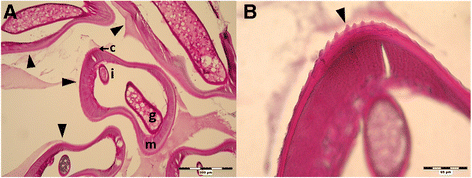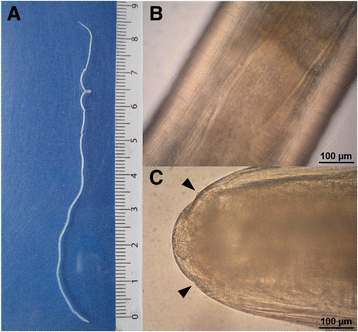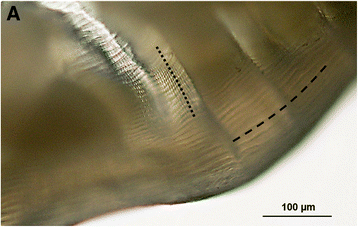Dirofilaria repens: emergence of autochthonous human infections in the Czech Republic (case reports)
- PMID: 27094256
- PMCID: PMC4837637
- DOI: 10.1186/s12879-016-1505-3
Dirofilaria repens: emergence of autochthonous human infections in the Czech Republic (case reports)
Abstract
Background: Human dirofilariasis is a zoonotic infection that continues to spread to previously unaffected areas of Europe. In the South Moravian Region of the Czech Republic (CR), imported as well as autochthonous canine infections were recorded in the last decade, and parasite DNA was detected in mosquitoes of Aedes vexans. In the present paper, human Dirofilaria infections are reported from the country for the first time.
Case presentation: The samples from five patients with suspected tissue helminthiases were investigated. In particular cases, nematodes were isolated from various tissues including skin of lower leg, soft tissues of finger, subcutaneous tissue of hypogastrium, lymph node and peritoneum. The diagnosis was based on light microscopic morphology and/or DNA analysis of the worms. In addition, ELISA examination of patients' sera for anti-filaria IgG antibodies was performed.
Conclusions: In the CR, five cases of human dirofilariasis caused by Dirofilaria repens were recorded during 2010-2014 (species determination for three of them was confirmed besides morphological also by DNA analysis). At least, three of the cases were of autochthonous origin (the patients are Czech citizens residing in South Moravian Region who have never travelled abroad). The findings confirm the natural setting of D. repens in South Moravian Region of the CR. Dirofilariasis should be therefore considered as endemic in this area where it may represent a significant risk factor for public health.
Keywords: Autochthonous diseases in Czech Republic; Dirofilaria repens; Emerging disease; Human dirofilariasis.
Figures





References
-
- Araya J, Kawabata Y, Tomichi N, Kaneko K, Hayashi K, Iwabuchi K, Iwabuchi K, Terasaki Y, Kawashima T, Watanabe M. Allergic inflammatory reaction is involved in necrosis of human pulmonary dirofilariasis. Histopathology. 2007;51(4):484–90. - PubMed
-
- Pampiglione S, Canestri-Trotti G, Rivasi F. Human dirofilariasis due to Dirofilaria repens. Review of the world literature. Parassitologia. 1995;37:149–194. - PubMed
Publication types
MeSH terms
Substances
LinkOut - more resources
Full Text Sources
Other Literature Sources

